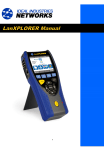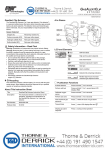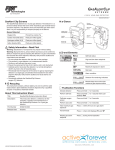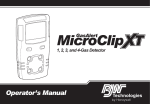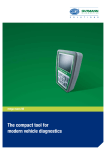Download Manual - Sure-Safe
Transcript
General Specifications Shelf life: 1 year before activation Weight: 76 g (2.7 oz.) Instrument dimensions: 28 x 50 x 81 mm (1.1 x 2.0 x 3.2 in.) Operating temperature H 2 S: -40 to +50°C / -40 to +122°F CO: -30 to +50°C / -22 to +122°F SO2: -30 to +50°C / -22 to +122°F O2: -20 to +50°C / -4 to +122°F Internal vibrating operates to: -15°C / +5°F Operating humidity: 5% to 95% relative humidity (non-condensing) Audible alarm: ≈ 95 dB at 30 cm (1 ft.) Visual alarm: Flashing, wide-angled alarm lens with quad red LEDs plus alarm LCD readout Display: Liquid crystal display (LCD) Ratings and certifications: Classified by UL to both U.S. and Canadian Standards as intrinsically safe for Class I, Division 1, Group A, B, C, D and Class I, Zone 0, Group IIC ATEX: CE 0539 g II 1 G Ex ia IIC T4 DEMKO 08 ATEX 0814213 IECEx: Ex ia IIC T4 IECEx UL 08.0018 CE: European Conformity ABS Type Approved VA-348-169-X Ingress protection: IP 66/IP 67 Safety Specifications Maximum operating life: 24-month detector: 2 years after activation, assuming 3-5 minutes of alarm time/day 36-month detector: 3 years after activation, assuming 1.5 minutes of alarm time/day Detection range: Sensor type: Electrochemical cells H 2 S: 0 to 100 ppm CO: 0 to 300 ppm Detection technique: Instantaneous alarm Alarm setpoints: Instant low and instant high Battery: Lithium, non-replaceable O 2: 0 to 30% by volume SO 2: 0 to 100 ppm Calibration: H 2 S, CO, SO 2: Not required O 2: Self-calibrating Note: This product has been classified for use in atmospheres not more than 21% v/v O2 . Event Logging Specifications Number of stored events: Up to ten events encountered. If more than ten, the older events are replaced by the newer events. Data transmission method: Via infrared port to thermal printer or via IR DataLink to PC (for ordinary locations only). Information transmitted: • Serial number • Life remaining • Self-tests performed • Total number and duration of all events encountered Last ten events: • Maximum exposure, MicroDock II bump check, O2 calibration, or auto zero Data shown for maximum exposures and bump checks: • Gas type and alarm level in ppm or % • Time elapsed since the alarm occurred in days, hours, and minutes • Duration of alarm in minutes and seconds This equipment has been tested and found to comply with the limits for a Class B digital device, pursuant to Part 15 of the FCC rules and ICES-003 Canadian EMI requirements. These limits are designed to provide reasonable protection against harmful interference in a residential installation. This equipment generates, uses and can radiate radio frequency energy and, if not installed and used in accordance with the instructions, may cause harmful interference to radio communications. However, there is no guarantee that interference will not occur in a particular installation. If this equipment does cause harmful interference to radio or television reception, which can be determined by turning the equipment off and on, the user is encouraged to try to correct the interference by one or more of the following measures: Data transmission time: 45 seconds plus 10 seconds per record -- Reorient or relocate the receiving antenna. -- Increase the separation between the equipment and the receiver. -- Connect the equipment into an outlet on a circuit different from that to which the receiver is connected. -- Consult the dealer or an experienced radio/TV technician for help. BW TECHNOLOGIES BY HONEYWELL GasAlertClip Extreme 2 or 3 Year Gas Detector D2139/9 [English] iERP: 128373 © BW Technologies 2009, all rights reserved. Instruction Sheet Introduction a Safety The GasAlertClip Extreme gas detector (“the detector”) is a personal safety device that warns when hazardous gas exceeds factory set alarm setpoints. The detector stores and transmits gas alarm event data. It is your responsibility to respond properly to the alarms. Warning: Substitution of components may impair Intrinsic Safety. Gas Detected Unit of Measure Oxygen (O 2) Percent by volume (%) Carbon monoxide (CO) Parts per million (ppm) Hydrogen sulfide (H 2 S) Parts per million (ppm) Sulfur dioxide (SO2) Parts per million (ppm) BW Technologies (BW) warrants this product to be free from defects in material and workmanship under normal use and service for a period of two or three years (depending upon detector), beginning on the date of activation. This Warranty is valid only if the detector is activated by the date on the package. This warranty extends only to the sale of new and unused products to the original buyer. BW’s warranty obligation is limited, at BW’s option, to refund of the purchase price, repair, or replacement of a defective product that is returned to a BW authorized service center within the warranty period. In no event shall BW’s liability hereunder exceed the purchase price actually paid by the buyer for the Product. This warranty does not include: a) b) c) EC Declaration of Conformity 1 Products covered by this declaration: GasAlertClip Extreme Manufacturer: BW Technologies 2840-2 Ave SE Calgary, Alberta Canada T2A 7X9 Description: Disposable, water resistant, single gas detector (detects 1 of 4 different toxic or oxygen gases). 4 b) c) proper storage, installation, calibration, use, maintenance and compliance with the product manual instructions and any other applicable recommendations of BW; the buyer promptly notifying BW of any defect and, if required, promptly making the product available for correction. No goods shall be returned to BW until receipt by the buyer of shipping instructions from BW; and the right of BW to require that the buyer provide proof of purchase such as the original invoice, bill of sale or packing slip to establish that the product is within the warranty period. THE BUYER AGREES THAT THIS WARRANTY IS THE BUYER’S SOLE AND EXCLUSIVE REMEDY AND IS IN LIEU OF ALL OTHER WARRANTIES, EXPRESS OR IMPLIED, INCLUDING BUT NOT LIMITED TO ANY IMPLIED WARRANTY OF MERCHANTABILITY OR FITNESS FOR A PARTICULAR PURPOSE. BW SHALL NOT BE LIABLE FOR ANY SPECIAL, INDIRECT, INCIDENTAL OR CONSEQUENTIAL DAMAGES OR LOSSES, INCLUDING LOSS OF DATA, WHETHER ARISING FROM BREACH OF WARRANTY OR BASED ON CONTRACT, TORT OR RELIANCE OR ANY OTHER THEORY. Since some countries or states do not allow limitation of the term of an implied warranty, or exclusion or limitation of incidental or consequential damages, the limitations and exclusions of this warranty may not apply to every buyer. If any provision of this warranty is held invalid or unenforceable by a court of competent jurisdiction, such holding will not affect the validity or enforceability of any other provisions. Contacting BW Technologies by Honeywell To contact BW Technologies by Honeywell call: USA: 1-888-749-8878 Canada: 1-800-663-4164 Europe: +44 (0) 1295 700300 Other countries: +1-403-248-9226 Email us at: [email protected] Visit BW Technologies by Honeywell’s web site at: www.gasmonitors.com BW Technologies by Honeywell Corporate Headquarters 2840 – 2 Ave. SE Calgary, AB Canada T2A 7X9 7 Standard Description EN 60079-11:2007 Electrical apparatus for explosive atmospheres–Part 11: Intrinsic Safety EN 50270:2006 Electromagnetic Compatibility – Electrical apparatus for the detection and measurement of combustible gases, toxic gases, or oxygen BW Technologies by Honeywell America 3279 West Pioneer Parkway Arlington, TX USA 76013 BW Technologies by Honeywell Europe 5 Canada Close Banbury, Oxfordshire United Kingdom OX16 2RT EN 60079-0:2006 Electrical apparatus for explosive atmospheres – part 0: General Requirements EN 60079-26:2004 Explosive atmospheres – part 26: Equipment with equipment protection level (EPL) Ga IEC 60079-11:2006 Electrical apparatus for explosive atmospheres–Part 11 Intrinsic Safety 1 Self-test status 2 High and low alarm setpoints 3 Data transmission 4 Maximum exposure in alarm Notifi ed Body DEMKO A/S Document EC Type Examination Certificate 5 Gas type Alarm condition 7/8 Detector life-remaining indicators 4/8 Months/hours/days since last maximum exposure Parts of the GasAlertClip Extreme Date 3 2009-01-16 Conformity of Production The manufacturer declares herewith that the production of all product(s) listed above meets the requirements of ISO 9001:2000. NSF International Strategic Registrations Quality Registrar, Canada under certificate No. 99167, certified this quality system on February 27, 2003. Name: Thomas A. Crawford, P. Eng 4 5 6 1 ec Note Pushbutton 2 08 ATEX 0814213 Do not activate the detector after the date on the package. This product is a gas detector, not a measurement device. Perform a self-test each day prior to use. Ensure the sensor grill is free of dirt, debris, and is not obstructed. Calibrate and bump test the detector in an ordinary location. Periodically test the response of the sensor to gas by exposing the detector to a target gas concentration that exceeds the low alarm setpoint. Manually verify that the audible and visual alarms are activated. Calibrate if the reading are not within the specified limits. • Periodically calibrate the GasAlertClip Extreme O 2 . This instrument contains a lithium battery. Do not mix with the solid waste stream. Spent batteries should be disposed of by a qualified recycler or hazardous materials handler. 2/6 UL International DEMKO A/S Testing and Certification Lyskaer 8, PO Box 514 Dk-2730 Herlev, Denmark Identification Number: 0539 Identification Number • • • • • • 8 Equipment and protective systems in potentially explosive atmospheres: The product(s) listed above conform to the relevant provisions of ATEX Directive 94/9/EC of March 23, 1994 and 89/336/EEC & 2004/108/EC. Conformity has been demonstrated with reference to the following Harmonized European Standards Pushbutton Description C • To activate the detector, press and hold C for 5 seconds. • Press C within 24 hours of a gas alarm to view the maximum gas exposure. • When Test displays, press and hold C for 1 second to activate the self-test. • To calibrate the O 2 detector, press and hold C for 3 seconds. • To display the gas alarm setpoints, press C. • To transmit the data, press C when Prn and display. • To auto zero, press C and hold for 3 seconds. Activating the Detector Press and hold C for 5 seconds. Note: Once activated the detector cannot be deactivated, except after a battery life-ending alarm. Refer to Safety Shutdown Mode. 7 Signature: Position: Manager Product Compliance, Certification & Conformity Factory addresses System Sensor de Mexico S DE RL DE C V Parque Industrial Intermex Ave Valle Del Cedro 1681 CP 32570 Juarez Chih. Mexico 4 6 3 The technical file is maintained at the manufacturer’s location fuses, disposable batteries or the routine replacement of parts due to the normal wear and tear of the product arising from use; any product which in BW’s opinion, has been misused, altered, neglected or damaged by accident or abnormal conditions of operation, handling or use; any damage or defects attributable to repair of the product by any person other than an authorized dealer, or the installation of unapproved parts on the product; or The obligations set forth in this warranty are conditional on: a) 5 2 Warning: Bump test the O2 sensor before each day’s use to confirm its ability to respond to gas by exposing the detector to a gas concentration that exceeds the alarm setpoints. Manually verify that the audible and visual alarms are activated. Warning: To prevent ignition of flammable or combustible atmospheres, disconnect power before servicing. Display Elements Limited Warranty & Limitation of Liability Information - Read First BW Technologies by Honeywell 2840 - 2 Avenue S.E. Calgary, AB Canada T2A 7X9 1 Audible alarm 5 Alligator clip 2 Visual alarm 6 Activate/test button 3 Infrared download port 7 Sensor and sensor grill 4 Liquid crystal display (LCD) 1 Performing a Self-Test Safety Shutdown Mode Note: The self-test must be performed in a safe atmosphere that is free of hazardous gas. After a self-test is performed, wait 30 seconds before using the detector to ensure it accurately detects gas. The LCD displays a blank screen when intiating safety shutdown mode. The detector beeps and vibrates, and the LEDs flash two times a second for 15 seconds. Then the LCD displays OFF or an error code, depending on the reason for safety shutdown mode. The self-test is activated prior to any other function. Prior to each day’s use, a self-test of the detector must be performed. If the event logs have not been downloaded, contact BW Technologies by Honeywell. When Test displays on the LCD, a self-test is required. The detector initiates safety shutdown mode if the When the self-test is performed and successful, u displays. To perform a self-test, press and hold C for 1 second. Confirm that the following tests are performed: The detector beeps and vibrates once, and the LEDs flash once. • self-test fails three consecutive times, • automatic battery test fails five consecutive times, or • detector has not been manually deactivated within 8 hours of the detector life-ending alarm activating. Factory Gas Alarm Setpoints Low Alarm Setpoint High Alarm Setpoint GasAlertClip Extreme O2 19.5% 23.5% GasAlertClip Extreme CO 35 ppm 200 ppm GasAlertClip Extreme H 2 S 10 ppm 15 ppm GasAlertClip Extreme SO2 5 ppm 10 ppm Model 1. All LCD elements display. 2. Test flashes while the sensor integrity and battery life are tested. 1. 3. The low and high alarm setpoints display. 4. If an alarm has occurred in the last 24 hours, the LCD displays the maximum gas exposure value and the hours that have elapsed since the exposure. Alarms Note: Detector may be configured with customer specified alarm setpoints. Contact BW Technologies by Honeywell. 3. 5. Prn and flash. Note: If a self-test is activated without Test being displayed, steps #1-3 are bypassed. Self-Test Pass If the self-test is successful, the detector beeps and vibrates once. u displays to confirm the self-test was successful. Displaying the Factory Gas Alarm Setpoints Press C during normal operation to display the factory gas alarm setpoints. Alarm setpoints are factory configured and cannot be modified. Self-Test Fail If the self-test fails, the detector beeps five times and the LEDs flash before displaying a blank screen. The LCD then returns to the normal operation screen and again displays Test. Repeat the self-test. Note: If the self-test fails three consecutive times, the LCD displays a blank screen and the detector deactivates. Refer to Safety Shutdown Mode. Visual Alarm Low Gas Alarm One slow beep every second One slow flash every second One slow vibration every second High Gas Alarm Two fast beeps every second Two fast flashes every second Two fast vibrations every second Life-Ending Alarm One beep, flash, and vibration every 30 seconds One beep, flash, and vibration every 30 seconds Vibration Alarm One beep, flash, and vibration every 30 seconds Note: When the gas level returns to the acceptable range, the alarm deactivates. The life of the battery decreases rapidly when in alarm conditions. The battery life-ending alarm occurs when the battery life-remaining clock displays 0 hours. The detector will continue to operate for 8 hours before automatically deactivating. Model Low Alarm Setpoint GasAlertClip Extreme CO 25 ppm GasAlertClip Extreme H 2 S 5 ppm GasAlertClip Extreme SO2 3 ppm Note: The auto zero must be performed in a safe atmosphere that is free of hazardous gas. 1. Press C for 3 seconds in a safe area, free of hazardous gas. If a self-test has been initiated within 22 hours, the following screen displays. The detector records the maximum gas exposure that triggers an alarm condition and begins calculating the number of hours since the maximum exposure. For each new exposure greater than the current maximum exposure, the detector resets the maximum gas exposure to the new level and resets the hours to 0. After 24 hours of gas readings in the acceptable range, the detector resets both values to 0. Press C within 24 hours of receiving a gas alarm. The LCD displays the following: The detector life-remaining clock indicates how much longer the detector will operate. The LCD displays the countdown value of remaining months, days, and then hours. If a maximum gas exposure has occurred within the last 24 hours, the maximum gas exposure screens display. The detector continues to operate for a maximum of 8 hours after the detector life-ending alarm activates. Press C to deactivate the detector. For more information, refer to Alarms. 2 flash. The detector stores the last ten events such as maximum gas exposure, bump test, and auto zero. The recorded data includes the • serial number, • detector life-remaining values (months/days/hours), • self-tests that have been performed, • total number of events that have occurred, • event type, • duration of all events encountered, • gas type, • alarm level(s) (ppm or %), • time elapsed since the alarm occurred (days/hours/minutes), and • duration of the alarm (minutes/seconds). Transfer Data Transferring Data to a PC To transfer the data to a PC, complete the following: If the maximum gas exposure is beyond the detection range, over limit (OL) displays. 1. Connect the IR DataLink to the PC. 2. Position the detector and the device 2 in. (5 cm) apart. 3. From the detector, press C to access the transmission screen. 2 4. Prn and Note Bump test the O 2 sensor before each day’s use to confirm its ability to respond to gas by exposing the detector to a gas concentration that exceeds the alarm setpoints. Manually verify that the audible and visual alarms are activated. Or Every 30 days, a calibration is due for the O 2 detector. The LCD flashes CAL and the detector life-remaining value displays. Detector Life-Remaining Clock Unsuccessful Calibration: If the detector does not beep or vibrate after a calibration, repeat steps #1 and 2 again. If the second attempt is unsuccessful, contact BW Technologies by Honeywell. • Print the data using the handheld IR printer The battery is automatically tested every 2 hours. If the battery test fails, another automatic test is initiated 30 minutes later. Note: After five consecutive battery test failures, the LCD displays a blank screen and the detector deactivates. Refer to Safety Shutdown Mode. 3. If an alarm has occurred in the last 24 hours, the LCD displays the maximum gas exposure value and the hours that have elapsed since the exposure. 4. The detector beeps and flashes. O2 flashes on the LCD. Successful Calibration: The detector beeps and vibrates once to indicate that calibration is successful and returns to normal operation. • Transfer data to a PC using an IR DataLink Calibrating the Oxygen (O ) Detector 2. The low alarm setpoint and high alarm setpoint display. 3. CAL flashes. While CAL is flashing, press and hold C for 4 seconds. Two options are provided to transmit the gas event data: The low and high alarm setpoints. Automatic Battery Test If a self-test has not been initiated in the last 22 hours, the detector performs a self-test. Refer to Performing a Self-Test. If a self-test has not been initiated in the last 22 hours, the detector performs a self-test. Refer to Performing a Self-Test. Gas Event Data Transmission Maximum Gas Exposure Viewing the Maximum Gas Exposure Performing an Auto Zero (for H2S, SO2, and CO only) An auto zero can only be performed when the low alarm setpoint is at or below the following setpoints. Twenty-two hours after performing the self-test, Test displays again to indicate that a self-test is required. Audible Alarm Display 2. Press and hold C for 4 seconds. If a self-test has been initiated within 22 hours, the following screen displays. A calibration may also be performed if the O 2 detector has not been used recently or is in false alarm. flash on the detector LCD. Within 5 seconds, press C 4. Prn and to begin the transmission. 5. While data is being transmitted, Y displays and flashes. A countdown timer displays as a percentage value (70%) and indicates how much data remains to be transmitted. a Warning If a calibration is required for a false alarm, verify it is in false alarm and ensure the calibration is performed in safe area that is free of hazardous gas in an atmosphere of 20.9% oxygen. To calibrate the O2 detector, complete the following: 1. Calibrate the detector only in a normal atmosphere (20.9% O 2) that is free of hazardous gas. 6. When data transmission is complete, the detector beeps and vibrates once. For more information, refer to the IR DataLink User Manual. Transferring Data to a Printer To transfer data using the handheld IR printer, complete steps 2-5 as listed for Transferring Data to a PC. 3 Contacting BW Technologies by Honeywell To contact BW Technologies by Honeywell call: USA: 1-888-749-8878 Europe: +44 (0) 1295 700300 Canada: 1-800-663-4164 Other countries: +1-403-248-9226 Email us at: [email protected] Visit BW Technologies by Honeywell’s web site at: www.gasmonitors.com BW Technologies by Honeywell BW Technologies by Honeywell BW Technologies by Honeywell Corporate Headquarters America Europe 2840 – 2 Ave. SE 3279 West Pioneer Parkway 5 Canada Close Calgary, AB Arlington, TX Banbury, Oxfordshire CANADA T2A 7X9 USA 76013 United Kingdom OX16 2RT






